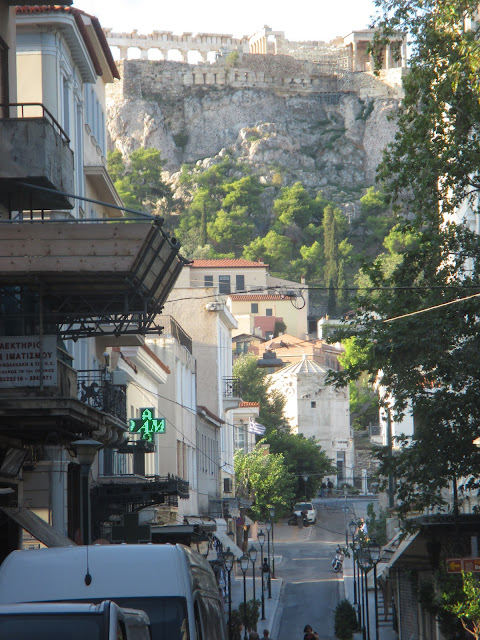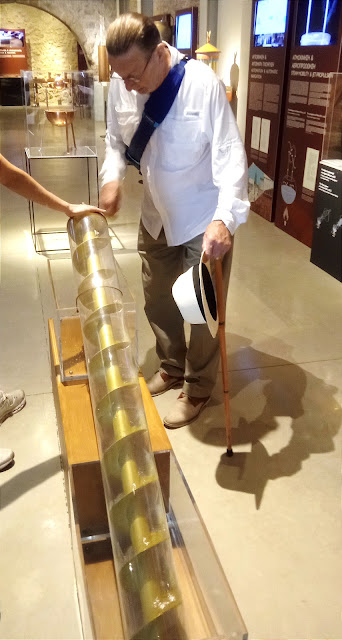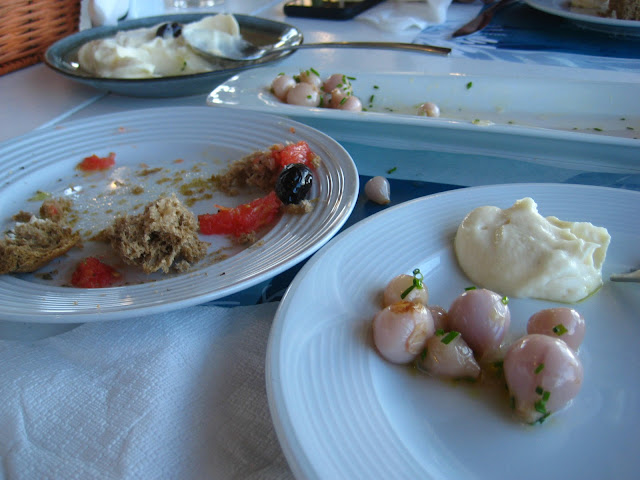September 18-19
Monday, our last day in Athens, we weren’t quite ready to eat breakfast at first, so we strolled less than a block from our door and came to Aiolou, a pedestrian street.
We hadn’t traveled far on Aiolou, maybe a block or so, and realized that the horizon was formed by the cliff of the Acropolis and a view of one of the temples.
It is the Erechtheion, the temple with the Porch of the Caryatids. From below, we were looking at the other side.
We made a turn and came to a wide plaza with the city’s cathedral and a statue of a former archbishop of Athens. A brilliant mosaic surmounts the entrance.
The inscriptions were in a Byzantine style using several ligatures that I can’t decipher. I did make out a kneeling man with wings who was addressing a woman identified as the Mother of God, so I’m guessing it depicts the Annunciation.
On the other side of the plaza was a tiny church, dedicated to Theotokos Gorgoepikoos, an epithet for the Virgin Mary, and to Saint Eleutherios.
According to Google, the church was built in the 12th century. There is more than one St. Eleutherios, including a Roman soldier martyred under Diocletian and a second century pope.
There is also a banner near the old church to welcome everyone to Plaka, the historic district of Athens.
For breakfast we stopped at Kariatis, a cafe on Aiolou. The meal had a little foreign flavor. I had an omelet and Greek coffee. Joanna had pancakes with honey and walnuts.
In the afternoon, we walked to the Museum of the Acropolis, mainly to get the photo of the day, Joanna among the Caryatids.
The walk, a little more than a kilometer, took a while, not only because I’m slower than I used to be, but more so because there was a lot to see.
It went through the old city, my favorite part of just about any town.
Our route started on Aiolou again. When we came to the first turn, we found a huge ruin. It was the vast remnant of a library that was built on the orders of Hadrian, the early second century emperor who is buried at the Castel Sant’Angelo in Rome.
The same Hadrian ordered the building of the wall that runs across Britain to keep the Picts out of the south, which was a Roman province at the time.
The library was a huge building. Parts of the old walls are still laid out. There seem to have been numerous chambers.
Joanna was joking when she said it was where all the thinkers used to live. But then we thought about it and saw it was possible. There may have been room enough.
A little farther on we came to a sign that read, “The Oldest House in Athens.”
It is the same house that Google Maps identified as “The Benizelos Mansion (House of St. Philothei).”
The Benizelos name, sometimes alternately transliterated as Venizelos, appears in various places around the city. It belonged to one of the patrician families of Athens. They traded in wine and olive oil. The house was part of a large property.
Part of the building dates to the 10th century, we learned. Most of what we saw was built much later, possibly the 15th or 16th century.
Overlooking the backyard, where the olive oil press once sat, is a bay window that could work as a set for a Shakespeare movie.
The first floor had the storerooms and working spaces for the servants. The upper floor had the living area for the family. One room, a kind of drawing room for family and guests, showed the influence of the Turks who ruled Athens at the time.
People didn’t sit in chairs. They reclined on mattresses. A large fireplace was at one end of the room. The chimney was conical. An illustration on display there shows an almost identical room at the time in a different Athens home.
St. Philothei was born Revoula Benizelos. After she was widowed at an early age, she refused to remarry. She became a nun and eventually established a convent dedicated to St. Andrew. The order taught domestic skills to young women.
Some of those young women were Moslem slave girls who had escaped from a harem. When the escapees were traced to her, Philothei was arrested and beaten. Influential friends bailed her out of jail.
As her reputation for charitable works spread, the Ottoman authorities became increasingly hostile. One evening in 1589, a group broke into the convent during a prayer service and beat Philothei again. This time, she did not survive.
The orthodox churches revere her as a New Martyr.
The Museum of the Acropolis sits right under the hill. We could see part of the Parthenon from the street.
Inside are artifacts from various ages. Some are votive pieces found in caves where small cults worshiped various deities of the Greek pantheon.
Many exhibits are representations of Athena, the city’s eponymous patron.
There is an installation of what remains of a battle scene in which Athena kicks the asses of some belligerent giants.
The Caryatids are the star of the show. Joanna stood in for the one Lord Elgin took for the British Museum.
When you get a close-up view, you can see the damage caused by age and air pollution. The statues were brought inside to avoid further deterioration.
The same precaution was taken with Michelangelo’s David in Florence. That original is almost 2000 years younger than the Caryatids and so shows less damage.
We had gotten to the Acropolis Museum late and closed the place. We closed the Louvre once, too, when we and the rest of the malingerers were swept out by guards and a guy with a broom.
They don’t use a broom in the Acropolis Museum, but they will bark at you.
Everyone went outside and started to take snapshots of the ruins exposed there.
A guard came out and, without barking, said we had to go past the gate, which was going to be locked.
Joanna and I went up the access ramp to the street where the Acropolis was looming over us.
We took one wrong fork on the way back and had to do some backtracking, but other than that we were pretty efficient in getting to Aiolou again and more important to a cafe, where we rested and took some wine and water.
We had made a reservation for dinner at a restaurant called Xenios Zeus, which advertised that it had views of the Acropolis. We even timed it right: dinner at sunset.
It was quite a climb to get there. Even the street had stairs.
I should have been suspicious when we saw that the place was near the hilltop and not on the roof of a building.
As they were taking us to a table, I scanned the horizon. “Where’s the Acropolis?”
On our way out, one guy made a last try at getting us to stay. He pointed off in one direction and said the Acropolis is in that direction. Only the trees get in the way.
We went back to the restaurant row outside the Noma. This time we tried a place called School Pizza Bar. We had a salad made with arugula. I had forgotten what a kick that leaf has.
School also had Roman-style carbonara on its menu. We had to go for that.
I ordered a bottle of red. Joanna had a little of it, and I polished off the rest, so I skipped the raki.
The next morning Joanna had already been awake for an hour when she woke me at six.
We were out of the hotel around nine and at the airport by 10, three hours early for our 1:10 international flight.
We checked the big bag and then ran into a glitch in security screening.
Joanna had bought five tubes of a lotion with olive oil and packed them in her carry-on. They were too many and too big. You’re allowed only three, no larger than three ounces each.
We had time. So rather than hand over the tubes, I took the bag back to the airline counter and checked it.
Even with that, we had time for breakfast. We shared a fairly good croissant and had yogurt that would have been much better without the stale granola mixed in it.
It was a turbulent flight, and they didn’t want us to stand up, even to go to the restrooms.
I passed on the food and drank a bit of water now and then. Joanna may have taken one of the snacks they handed out. I’m not sure. For the most part, though, dinner was a handful of nuts for each of us. Oddly, it was enough.
We had booked through United, but the carrier for the trip home was Air Canada. We flew 11 hours to Toronto and then had to go through U.S. government pre-check. They were already boarding our connecting flight when we got to the gate.
But they were boarding early. A number of passengers were coming from an international flight that had been delayed. The airline wanted us all in the plane before the late wave arrived.
The flight left about a half-hour behind schedule.
We were wearing down fast. Pre-check in Toronto spared us the interminable passport control lines in Newark. That was a break.
There is a new terminal at Newark Liberty Airport. Uber gets prime pickup space. The cab stand has moved to one end of the long platform. We couldn’t find it at first.
The terminal looks great inside, but the airport still runs with the inefficiency and semi-incompetence of the Port Authority of New York and New Jersey.
We got home around 10 p.m. That’s about 5 a.m. Athens time.
Except for a few very brief dozes on the planes, Joanna had been up for 24 hours straight. It was only 23 hours for me.
It felt great to conk out.
Here’s hoping the best for everyone.
Stay well, be happy, and don’t forget to eat your arugula.
Love to all.
Joanna and Harry
















